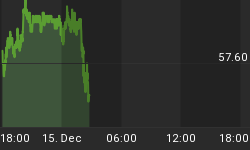Since we first wrote about it in December, we have been watching a beautiful example of a b-wave triangle develop in copper. In February, it presented traders with a fantastic opportunity to enter short with minimal risk. For readers who took advantage of the trade, we provided updates in March and May that also can be useful in understanding how the pattern developed.
While we don't think the big trade is nearly finished, there may be another opportunity to get onboard somewhere near the present area.
On the monthly chart below, you can see how copper broke downward out of the big triangle and has approached the first support area. We believe the bounce from that area probably represents wave (ii) of what should become a five-wave move into lower support.

This makes sense in the larger picture. First, the price of copper is widely regarded as a bellwether of economic activity, especially in countries such as China, that are experiencing rapid development of industry and infrastructure. The decline during the first half of 2013 coincides with diminishing expectations for growth in China and elsewhere.
Second, as readers who have been following our posts about the U.S. Dollar might have noticed, consolidation in copper happened at the same time we saw consolidation in the Dollar. We have described our expectation that the Dollar Index will find support near its current level and will climb upward in coming months. That would almost certainly correspond with a renewed bearish trend for copper.
On the weekly chart, copper's consolidation fits well with the idea of an upward wave (ii). If that is the case, then we should soon see a strong downward wave (iii) into one of the support areas shown, 2.65-2.76 or 2.10-2.18.

Of course, there are some caveats. Even if the recent upward move was part of wave (ii), it would be possible for the retrace to extend higher. A wave (ii) also could extend farther in time. Thus, a trader who enters near the present area would need to allow for wider stops than the trader who entered nearer the upper boundary of the triangle in February.
There is much more of this kind of information about a wide range of traded markets at Trading On The Mark. Come see for yourself how much more profitable you can be when you see the trades ahead of almost everybody else in the market. We offer two subscription levels -- one tailored to the occasional swing trader, and another for more active professional and day traders.
Visit TOTM go get guidance about the markets, have your questions answered by experienced traders, and fill in the missing pieces of your successful trading plan!
Trading futures and options involves the risk of loss and is not suitable for all investors. Nothing in this article should be construed as a recommendation to buy or sell financial instruments.
















